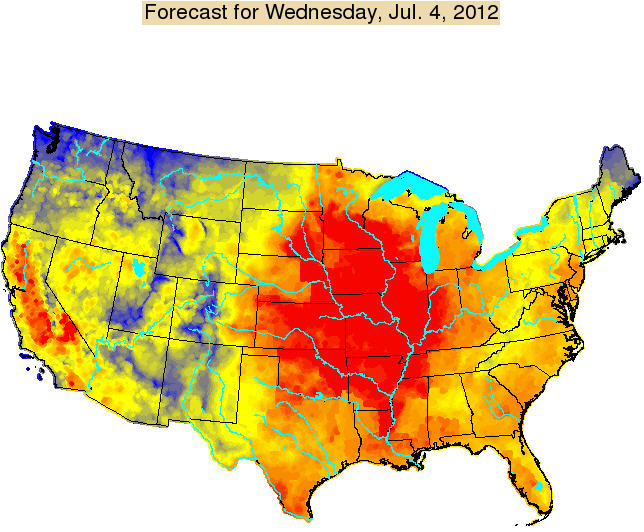Watch Livestock in Emergency Heat Stress Areas

USDA's heat stress forecasts show emergency heat levels for much of the central U.S. through July 6th.
For livestock that means heat indexes will reach high enough levels to be a danger to cattle and other livestock.
Dr. John B. Gaughan of the University of Queensland, Gatton, Australia, is an expert in the area of cattle heat stress. Some actions he recommends to take during an extreme heat event:
1. DO NOT MOVE ANIMALS.
2. Observe animals for signs of heat stress.
3. Consider wetting the animals or the ground.
When wetting the animals use large droplets (150 micron diameter sprinklers) not a fine mist, and wet the animals to the hide to saturate the hair for maximum cooling effect. The water should run off the animals. Wetting is efficient where there is wind and low relative humidity. Night sprinkling may be effective. Ensure that there is adequate water to maintain cooling. Once sprinkling commences it will need to continue until the heat wave conditions abate. Be prepared to sprinkle for up to 5 days. If pens are wet, after rain for example, adding water will further increase humidity within the pen. Consider multiple sprinklers, a minimum of 3 per pen, at various locations within a pen. These sprinklers can be turned on and off in attempt to reduce mud holes. Avoid locating sprinklers around water tanks, feed bunks, or shade.
Use caution if fire trucks are used to wet cattle. If cattle are not used to this treatment they may run away from the water, which could make the situation worse.
The soil in a feedlot absorbs and retains heat well. Ground temperatures in the feedlot are typically 20 ? 50 °F warmer than the air temperatures. During an extreme heat event the surface of the feedlot can exceed 150 °F. Adding water to the ground will cool the surface as the water evaporates, but be careful not to create mud holes.
Follow this link to see heat forecast maps for your region.








